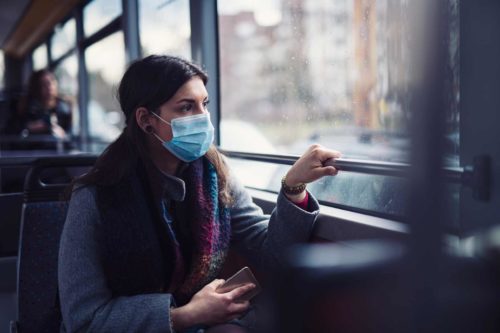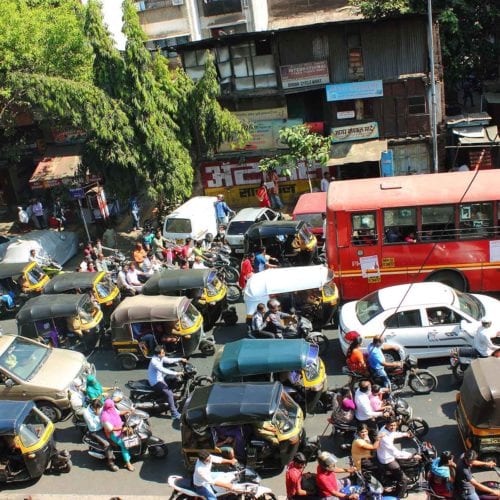Young woman wearing protective face mask, she sitting in bus transportation in the city.

From In Trouble to Informed
How Data Access Can Help Mass Transit Recover from COVID-19
As the coronavirus swept around the world, dramatic upheaval followed in its wake. Many industries have been devastated while others have boomed, joblessness has spiked as automobile emissions and mobility demand have plummeted. The global trend of becoming increasingly digital was swiftly accelerated, making many feel isolated while others collaborated like never before to resolve mask shortages or design online classes.
Emerging from lockdowns has been almost as tumultuous, as essential workers grapple with revised safety standards at work, and transit agencies navigate new challenges in getting them there. As more people begin moving about their cities, public transportation services will face the paradox of needing to provide affordable and safe mass transit at a time when “mass” is such a poignantly dangerous word.
The scale of the problem is vast. Lockdowns saw public transportation ridership decline as much as 90 percent in some cities around the world. In cities such as London, social distancing guidelines reduced metro capacities to a mere 13–15 percent of pre-pandemic levels, barely enough to accommodate essential workers. As cities continue reopening, however, increasing travel demand will quickly exceed reduced capacity levels, even as public fear of using mass transit endures.
During the recovery period, transit agencies will have to contend with six-foot social distancing guidelines (physical limitations), public fear of traveling en masse (perceived risk), and reduced funding available for infrastructure or fleet improvements (limited revenue). Failure to address these challenges as travel demand returns, risks limiting the mobility options of transit-dependent citizens while increasing congestion and tailpipe emissions as others are driven to adopt private modes of transportation.
Improving access to mobility data, however, can help transit operators and travelers avoid these consequences. Many operators already use their own data to drive decision-making. However, creating a system that aggregates mobility data across a city’s entire transportation ecosystem and makes that data retrievable through open APIs has the potential to be far more powerful.
With access to this wealth of aggregated data, application developers could build user-facing apps that provide travelers with new forms of information. This information could include the current occupancy of an arriving bus, its safe capacity, and the time since it was last sanitized—data points that were not given much importance before COVID, but are critical now. Transit agencies could better understand travelers’ needs, allowing them to reallocate underutilized resources, target demand more effectively, and manage vehicle occupancy more responsibly. Combined, improved access to mobility data can help transit agencies address the three key challenges to ramping up services: physical limitations, perceived risk, and limited revenue.
Challenge 1: Physical Limitations
Though the capabilities of data cannot negate the physical constraints introduced by social distancing guidelines, they can help passengers and transit providers safely navigate them. First and foremost, a system of aggregated mobility data could facilitate accurate and real-time demand tracking and forecasting, down to the current occupancy of a given transit vehicle. Armed with this visibility, travelers could make informed decisions regarding which buses or metro cars can safely accommodate them, helping to mitigate fears associated with using mass transit, and even increasing ridership within safe limits. For instance, the Danish rail transit provider DSB experienced a 6 percent increase in ridership after releasing an app that communicates vehicle occupancy information to travelers.
Transit providers, in turn, would be able to mitigate crowding in vehicles, at stations, or at other choke points by preemptively curtailing services, a technique used successfully in Paris, or by adjusting routes and frequencies to most safely service demand. Transit agencies could also collaborate with employers and universities to stagger daily start times to distribute mass transit demand throughout the day, as has been trialed in New York City and others in the Netherlands. Since the aggregated data system is designed to enable coordination between various entities, mobility companies or otherwise, it could be used to facilitate the cooperation required for this approach to succeed.
Challenge 2: Perceived Risk
In addition to the physical limitations brought on by occupancy caps, public transportation agencies will face the challenge of contending with the perceived health risks of mass transit ridership. Despite mounting evidence to the contrary, public transportation has been blamed for COVID-19 transmission in cities worldwide, earning it a dangerous reputation that will be difficult to dispel. This is especially true as governments and employers continue encouraging people to stay home and avoid crowded spaces.
The aggregated data system can do more than enable passenger counting and occupancy tracking, however. It can also enable robust communication channels between providers and passengers. Data points capturing when a bus or metro car was last sanitized, or how often public facilities at a station are disinfected, for example, could be disseminated to travelers through mobility apps built upon the system. Face mask requirements could be directly communicated, with the potential to return mass transit to 40 percent of pre-pandemic levels.
While somewhat counter-intuitive, the aggregated data system could also assuage public fears by shifting demand away from mass transit itself by promoting shared bicycle, taxis, or e-scooter services. This could help transit agencies provide low-cost mobility to those who depend on it without losing public confidence due to overcrowding.
Challenge 3: Limited Revenue
Compounding all other challenges faced by public transportation agencies is the struggle to adjust, problem solve, and develop solutions while managing massive budget shortfalls. Sharp declines in ridership—which will likely persist for months and perhaps years to come—have stifled revenues, making it imperative for providers to operate at peak efficiency and reduce costs while maintaining safety standards.
A critical feature of the aggregated data system is that it can provide real-time visibility into travel patterns and shifts, helping mobility providers better understand travel demand. This kind of visibility is essential for bus and metro networks to optimize routes and/or route frequencies. Instead of investing in additional resources for which funding may not be available, the aggregated data system can empower mass transit providers to reallocate underutilized resources to make the best of what they already have.
As a facilitator of multi-modal transportation, the system also has the potential to improve first- and last-mile connectivity in low-density areas: regions that experience low ridership in the best of times and that are going to be scrutinized by agencies looking to cut costs. These improvements could allow transit providers to explore cost savings in these areas (through reduced bus/metro frequency, for example), without sacrificing accessibility for transit-dependent essential workers and others who might live in those regions.
Stitching Together a Safer Journey
Cities and transit agencies around the world have had success leveraging one or two of these strategies for negotiating reduced capacity, mitigating perceived risk, and operating under tight budgets. Improved access to aggregated mobility data, however, would make it possible for them to pull all solutions together. For travelers, this system would provide the transparency required to stitch together a safer journey. Transit agencies, for their part, would gain the flexibility to negotiate uncertain demand, the data needed to optimize resources, and the platform to communicate safety measures to travelers. All told, accessible aggregated data can provide the tools to help mass transit not just recover but also become an even more viable and sustainable alternative to private vehicles in the post-COVID world.
RMI’s India Mobility team is working with stakeholders in Bangalore to develop a strategy for leveraging mobility data to improve the quality of and access to mobility solutions, particularly in a post-COVID world. This work stems from the Bangalore Urban Mobility Lab hosted in February 2020

